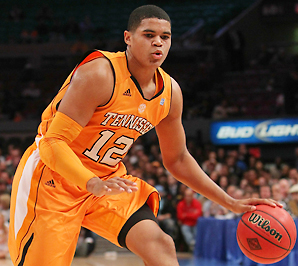RTC NBA Draft Profiles: Tobias Harris
Posted by jstevrtc on June 5th, 2011Player Name: Tobias Harris
School: Tennessee
Height/Weight: 6’7, 225 lbs.
NBA Position: Small/Power Forward
Projected Draft Range: Mid to Late First Round
Overview: In his single season at Tennessee, Tobias Harris ended up as the second leading scorer (15.3 PPG) on a squad that had only two players average double figures for the year (Scotty Hopson, 17.0 PPG). He was the Vols’ most efficient player, posting a 14.4 rating, far ahead of Hopson’s 10.7. His 7.3 boards per game was second on the team by a mere tenth of a carom and ranked him seventh in the SEC. Even though he led his team in blocked shots, he averaged less than a single rejection a game (0.9). He impressed with his handle and especially his strength for such a relatively young player, and he showed an ability to finish in the lane that was better than expected. His biggest drawback, though, was his lack of a formidable jumper, and in his short stint in Knoxville the improvement in his back-to-the-basket post game never materialized.
Will Translate to the NBA: His body. He’s not exactly NBA-ready, but he’s still got a couple more years of physical development. The worst thing he could do is assume that because he’s in the NBA, he’s therefore done with places like the weight room and the healthier sections of the supermarket. His work ethic is better than college players with even more experience, so there’s no reason to think he’ll start taking it easy at this early stage. This means in a few years he could be even more physically imposing than he is now, and he’s obviously ahead of the curve for his age. He’s shown skill in finishing near the basket with either power or touch; he’ll need both at the next level where the defenders are quicker, stronger, and can jump higher. In our view, his biggest positive besides a powerful frame that should only get bigger is how he can put the ball on the floor and get to the hole. When paired with his upper-body strength, that’s a skill that will serve him well in the league.
Needs Work: Harris needs to develop a library of moves off the block and he has to put in some serious hours extending the range of his jump shot, which is only a couple of feet past nonexistent. As mentioned above, he’s still got room to grow, but he can’t get complacent. A body that hasn’t finished developing can go either way. We’ve all seen young draftees eschew this part of their responsibility in reaching their full potential, and Harris has to stay committed to the task in the weight room and has to listen to his strength coaches wherever he lands.
Comparison Players: A pair of players who come to mind are Brandon Bass at the power forward position and Al Thornton at the small forward position. Neither has range on their shot, but both have managed to carve out effective niches for themselves in the NBA as offensively-oriented forwards who can get their points when needed. If Harris eventually develops a reliable jumper, something that neither Bass nor Thornton have done, he could position himself as a jump-shooting wing in the mold of Shane Battier or Danny Granger. He’s a long way from that right now, though.
Best Case Scenario: If he finds a nice jumper out to around 12-15 feet and creates a selection of post moves for himself, Harris could start for an NBA team in a few years. It won’t happen quickly, and it won’t happen until those gaps are filled, but with time and some coaching it’s a realistic best-case possibility.
2014 Projection: The Best-Case Scenario section could easily be combined into this one, because Harris will reaching his physical peak about two or three years from now, and, if we’re ever going to see that jump shot or that bag of block moves, it’ll be by 2014. Even with a little improvement in those areas, Harris will still be on an NBA roster in three seasons, and the amount of minutes he gets will depend on how far he comes in filling those gaps.
Best NBA Fit: Hitting the league at a young 19 years old, Harris will need to find a team where he’s allowed to learn on the job. If his team is too accomplished, he’ll probably be buried at the end of the bench for a couple of seasons. So a bad team that has ended up with another pick in the second half of the first round would be ideal — the Washington Wizards at #18, the Minnesota Timberwolves at #20, or the New Jersey Nets at #27 would make good sense.
Scout’s Take (Chris Denker from Netscouts Basketball): “Similar to Kawhi Leonard, but not as great athletically… some hand skills but think Leonard is the better pick at this position.”











































